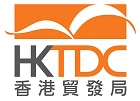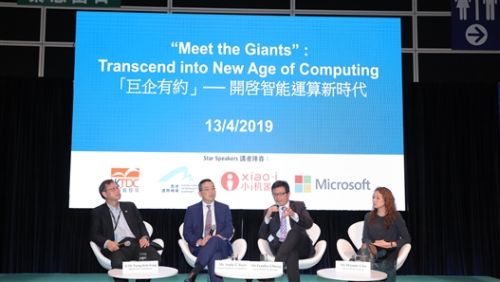|
| Thursday, 18 April 2019, 17:00 HKT/SGT | |
| |  | |
Source: HKTDC | |
|
|
|
|
| Industry experts discuss how to effect a digital transformation |
HONG KONG, Apr 18, 2019 - (ACN Newswire) - Leading technology experts came together on the first day of the HKTDC International ICT Expo on 13 April to discuss how advances in computing technologies have helped to make airports, businesses and governments smarter, more efficient and more cost-effective. The expo was organised by the Hong Kong Trade Development Council (HKTDC) and ran concurrently with the 16th HKTDC Hong Kong Electronics Fair (Spring Edition).
 | | The "Meet the Giants": Transcend into New Age of Computing seminar, organised on the first day of the HKTDC International ICT Expo, saw speakers sharing how artificial intelligence and the Internet of Things can synergise to lay the groundwork for smarter cities and more efficient organisations. |
Smart airport transforms passenger experience
Hong Kong International Airport (HKIA) is taking biometrics and robotics to new levels in its digital transformation, aiming to provide passengers with a more efficient and enjoyable airport and travel experience, and to improve operational efficiency. Andy Bien, Chief Information Officer at Airport Authority Hong Kong (AA), explained the five key enabling technologies for realising the AA's Smart Airport Vision: big-data intelligence, advanced biometrics, mobile technology, robotics, and the "digital twin" reality modelling system.
Advanced biometric applications are helping the AA provide a seamless travel experience by combining all passenger airport interactions - self-bag drop, e-security gate, immigration, transfer security gates and self-boarding gates - into a single token. "When the system is complete, the passenger will be able to walk into the restricted area in about 10 seconds," said Mr Bien.
The AA is also developing long-range iris, palm-vein and finger-vein scanning, and deeper functions such as emotion recognition via smart CCTV for enhanced security, he said. The analysis of each detected face provides a confidence score for seven different kinds of emotions: anger, disgust, fear, sadness, happiness, surprise or neutral.
Robotics is another area the AA is focusing on to supplement its huge labour force (currently 75,000 people and forecast to increase to 130,000 when the third runway opens). Mr Bien emphasised the fact that robotics integration was intended to supplement, not replace, airport workers.
Driverless tractors will soon be deployed to tow luggage carts on roadways and through facilities at HKIA, he said. This is especially important in the airfreight area, with HKIA being ranked first in the world in terms of air cargo traffic for nine consecutive years. The robotic tractors will enhance road safety and replace mundane tasks by high-tech jobs, he explained.
Indoor multi-function robots are also being tested in the airport, he said. They all have a common base platform, which handles the navigation, but the top section can provide many different functions, the most important of which is in-terminal patrols for environmental data collection and facilities monitoring. The robots can supplement the labour-intensive human patrols, monitoring things like lighting, temperature, humidity and Wi-Fi signals, Mr Bien explained.
He added that video analytics is another artificial intelligence (AI) function the AA is using to enhance safety in the airport. Intelligent CCTV cameras can detect abnormal situations, such as facility damage, unusual crowds and suspicious items, to ensure a quick response.
Accessible data essential fuel for smart government
Franky Chung, Chief Financial Officer of Xiao-i Robot Technology, said the company is a big investor in research and development (R&D), especially in natural language processing. "We offer AI solutions to help improve work efficiency, enhance city management and sustain economic development," he said.
Three characteristics are required in creating a smart city model, he said: vision, planning and facilities. "In creating a smart government, specific infrastructure, including cloud computing, a data resources platform and an Internet of Things (IoT) Internet perception platform, is essential to cater for different government departments," Mr Chung said.
In Hong Kong, one problem is that many data are not shared across government departments, he explained. For example, in the central government hotline service connecting the public to 22 departments, he said officials often do not know how other departments handle complaints reported by residents, such as felled trees or broken traffic lights.
By contrast, in Mainland Chinese cities such as Guiyang, where Xiao-i has helped implement smart city programmes, all government departments are connected and it is clear which department is responsible for what. WeChat is used instead of a hotline and chatbots are used instead of humans. In one city, a chatbot can handle 2,000 to 3,000 calls a day, and accuracy in handling enquiries was increased from 60% to 90%. This benefits the government by improving efficiency and boosting citizens' approval of the government. But committing to build a smart city requires determination, said Mr Chung.
Mr Chung discussed other advantages of chatbots: lower cost, greater knowledge and the ability to be available 24/7 to answer city residents' questions about healthcare, housing, tourism and transportation, for example. Xiao-i's chatbots are used in 80% of the top banks in the mainland and in large retail, e-commerce and telecommunications companies throughout the country.
What is the future of AI? "Data will be made more accessible at all levels. The advancements in big data algorithms will help governments and companies solve problems and improve the quality of life. AI will be everywhere and, in every industry," he concluded.
Microsoft moves into AI, big data and cloud computing
Microsoft has been a household name for decades now, with almost every home, school and office in Hong Kong using one Microsoft product or another, pointed out Winnie Chu, Head of Business Group (Cloud and Enterprise) of Microsoft Hong Kong. Microsoft is also heavily investing in AI, cloud computing and "intelligent edge" - the analysis of data and development of solutions at the site where the data is generated. The company's current mission is to empower every person and organisation on the planet to achieve more. "It's not about what tech can do, but what we can do with tech," said Ms Chu.
She emphasised that the digital revolution would result in job transformation, not displacement. In the next three years, she said, it was estimated that 21% of jobs would be unchanged, 37% of jobs would require retraining and new skills, 19% would be outsourced and 23% would be new roles due to digital transformation investment.
Microsoft AI is based on three principles, said Ms Chu: enabling people, inclusive design, and building trust into all its technology. She introduced examples of Microsoft's successful involvement in AI in Hong Kong, including global shipping and logistics at OOCL, public healthcare at the University of Hong Kong, property and real estate at Ricacorp, and fintech at Money SQ, an online lending platform in Hong Kong.
Ms Chu explained how edge computing is enabling IoT, using the intelligent cloud. Sending data from sensors such as cameras, lights, mobile devices, computers and drones to the cloud for analysis is slow and expensive, she pointed out. But now, the brain can be distributed into the devices themselves, so that analysis and decisions can be made immediately, eliminating transport and storage costs. Rolls Royce does this with its airplane engines using Microsoft technology with IoT and AI. Sensors can detect a problem while the plane is in the air, allowing maintenance to be scheduled before the plane lands instead of waiting for the regular maintenance schedule, so the engine is working perfectly before the plane takes off again. "This is only available through IoT," said Ms Chu.
Ms Chu concluded by encouraging all members of the audience to accelerate their IoT journey. "Start small in your company, she suggested. "We can be the ones to make a difference in our companies to empower billions."
Photos download: https://bit.ly/2UWiPZy
Contact:
Natalie Wong, Tel: +852 2584 4472, Email: natalie.hy.wong@hktdc.org
Sunny Ng, Tel: +852 2584 4357, Email: sunny.sl.ng@hktdc.org
Topic: Press release summary
Source: HKTDC
Sectors: Electronics, Construct, Engineering
http://www.acnnewswire.com
From the Asia Corporate News Network
Copyright © 2025 ACN Newswire. All rights reserved. A division of Asia Corporate News Network.
|
|
|

|
|
|
|
| HKTDC |
| Dec 12, 2025 22:15 HKT/SGT |
|
HKTDC 4Q25 Export Confidence Index: 2026 Hong Kong Export Growth of 8-9%, Sustained AI product demand lays solid foundation for future expansion |
| Dec 8, 2025 15:06 HKT/SGT |
|
Business of IP Asia Forum and Entrepreneur Day events conclude |
| Dec 4, 2025 21:00 HKT/SGT |
|
Business of IP Asia (BIP Asia) Forum and Entrepreneur Day open today |
| Dec 3, 2025 21:44 HKT/SGT |
|
The 26th Hong Kong Forum marks successful completion |
| Dec 3, 2025 20:52 HKT/SGT |
|
DesignInspire opens today, showcasing over 260 local and global design brands |
| Nov 28, 2025 17:03 HKT/SGT |
|
Think Business, Think Hong Kong strengthens Italy-Hong Kong ties and opens new path for Asian collaboration |
| Nov 26, 2025 11:40 HKT/SGT |
|
Stage set for DesignInspire with VIP preview on 3 December and free entry for industry and public over next three days |
| Nov 20, 2025 18:29 HKT/SGT |
|
BIP Asia Forum and Entrepreneur Day set for December |
| Nov 20, 2025 11:33 HKT/SGT |
|
Think Business, Think Hong Kong returns to Milan to deepen Hong Kong-Italy business ties |
| Nov 18, 2025 18:53 HKT/SGT |
|
15th Asian Logistics, Maritime and Aviation Conference draws to successful conclusion |
| More news >> |
 |
|
 |
|